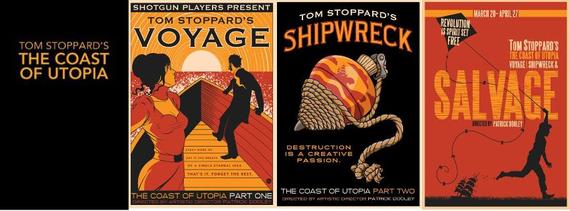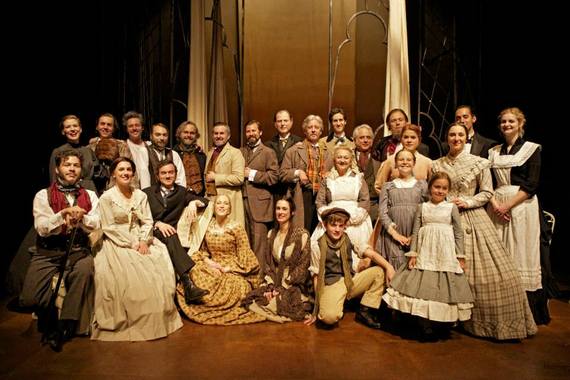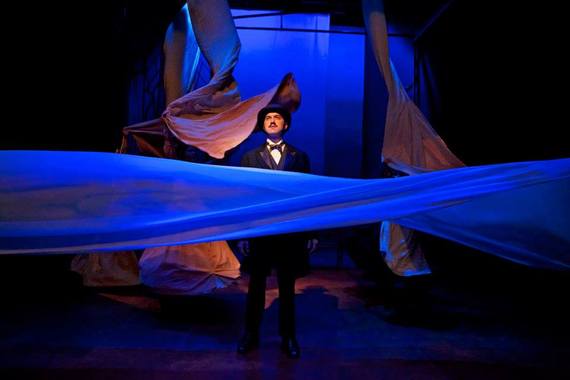"Oh crap, that song is soooo tired," groaned one of the towel boys at the gym as the music changed on the sound system. "I mean, like, ewwwwww....that must be two years old already!" As I watched his little pity party, I couldn't help but wonder: Where does that put the music of Beethoven, Bach or Mozart on the list of the greatest musical hits of all time?
Some people fear the past, others have a peculiar talent for cherishing the passage of time. As Ko-Ko sings to Katisha in Gilbert & Sullivan's 1885 comic opera, The Mikado:
There is beauty in extreme old age.
Do you fancy you are elderly enough?
Information I'm requesting on a subject interesting
Is a maiden all the better when she's tough?Are you old enough to marry, do you think?
Won't you wait until you're 80 in the shade?
There's a fascination frantic in a ruin that's romantic
Do you think you are sufficiently decayed?
Politicians, warriors and self-important fools frequently fail to learn anything from the past. But for creative types, the past offers a wondrous portal which invites them to explore science and history (as well as the history of comparative religion, costume design, distant cultures and lots more).
Don't believe me? Let's take paleontology as an example. Lots of kids are introduced to dinosaurs when they are young. Their parents will often buy them plastic replicas of the giant lizards or model kits which allow them to build a dinosaur skeleton. Some feel that Barney the Dinosaur is their own special friend.
Thanks to advanced CGI animation, many families have learned tremendous amounts about prehistoric monsters from movies like Jurassic Park (1993) and television specials like Walking With Dinosaurs (1999). Visits to natural history museums allow children to see fossils of bizarre creatures like the Permian era's Dimetrodon and the Cretaceous period's Pachycephalosaurus (up to and including the fierce and fiercely popular Tyrannosaurus Rex). Touring stadium shows even offer state-of-the-art audio-animatronic dinosaurs as a form of family friendly entertainment.
But how did dinosaurs become such a popular form of entertainment?
- In 1912, Arthur Conan Doyle's novel, The Lost World, captured the public's imagination.
- In 1914, the pioneering animator Winsor McCay took an early stab at giving an anthropomorphic personality to a brontosaurus named Gertie.
Fast forward to 1925, when a silent film adaptation of The Lost World was released. Although the following clip contains the entire 90-minute film, if you start at the 45, 64 and 69-minute marks you'll see some spectacular footage of early dinosaur models being put to work in cinema.
There can be no doubt that these artistic adventures were labors of love. New plays are often developed because a writer is so in love with a particular subject matter, style or concept that his all-consuming nostalgia for a particular chapter in history spurs him to create his own tribute to something he dearly loves. Two recent Bay area productions practically glowed with that kind of nostalgia and adoration for history, style and craft.
* * * * * * * * * *
Many would argue that Richard Wagner's 19-hour tetralogy, Der Ring des Nibelungen, is the greatest piece of performance art to be created during the 19th century. Not only does the composer's use of leitmotifs help to anchor and further the story, it adds an extra dimension to the Norse sagas which inspired this massive undertaking.
If one were looking for a narrative piece about social injustice and political revolution, one might point to Victor Hugo's 1862 historical novel, Les Misérables, which received a new lease on life in September 1980 with the Paris premiere of an adaptation for the musical stage (with book and music by Alain Boublil and Claude-Michel Schonberg). But what if you were looking for something smaller and less operatic than Wagner's Ring cycle but more intellectual and less showy than Les Miz?
Poster art for Tom Stoppard's trilogy, The Coast of Utopia
You'd find yourself exploring Tom Stoppard's 2002 trilogy, The Coast of Utopia (which consists of Voyage, Shipwreck and Salvage). Over the past three seasons, the Shotgun Players has been building toward this spring's chance to present marathon days in which audiences could be transfixed by the entire trilogy. As Patrick Dooley (the company's artistic director who staged the trilogy) remarked in his program note:
For the past three years, I've had the pleasure of absorbing the agony and ecstasy of the nearly seven-hour drama appearing before you. Over this time, the depth and breadth of this piece has continued to give me great consolation as I have navigated the pitching flotsam and jetsam of my own life. Like any great work, it reveals itself anew with each conversation, each reading, each rehearsal. The complexity of language and imagery is the closest to Shakespeare I've ever experienced and yet its ultimate message (as I see it today) is almost childlike in its simplicity: Do your best, while hurting the least. The genius of evolution (both political and personal) is only possible with the gifts of hardship and adversity. Yes, we continue to see certain tragedies circle back around, but they are usually just echoes of the past. The wheels of progress may turn slow, but they are sure.
The Shotgun Players' cast of Salvage (Photo by: Pak Han)
With its large cast, historic narrative and epic sweep, The Coast of Utopia is much more about philosophy and personal relationships than about pomp and pageantry. The challenge for the Shotgun Players team was to find a way to produce this massive work with a tiny budget on a postage stamp-sized stage while still managing to "bring the magic."
Kenny Toll as the Nihilist in Salvage (Photo by: Pak Han)
Much of this was accomplished by a creative team whose intense dedication and vivid imaginations had been focused with laser-like clarity on their singular artistic vision. Thanks to the production's immensely talented set designer Nina Ball, costume designer Heidi Hanson and director Patrick Dooley, I was pretty much gobsmacked by how superbly the mid-19th century was evoked, how meticulously scene changes were effected, how seductively the audience was introduced to the politics, neuroses and physical ailments of certain characters -- and how Stoppard's drama unfolded within the confines of the tiny Ashby Stage with a heartbreaking sense of historical sweep and dramatic momentum.
Megan Trout (Natasha Tuchkov) and Patrick Kelly Jones
(Alexander Herzen) in Salvage (Photo by: Pak Han)
This doesn't happen easily in most theatre companies (whatever their size), which is why the scope of Shotgun's achievement should not be taken for granted. Staging Stoppard's trilogy is a monumental undertaking (each installment by Shotgun's talented ensemble has been given the utmost love and attention). The production of Salvage was anchored by the remarkably versatile Patrick Kelly Jones as Alexander Herzen with an impassioned performance by Megan Trout (doing some of her finest work in recent years) as Natasha Tuchkov.
Strong support came from John Mercer (Worcell), Sam Misner (Nicholay Ogarev), Richard Reinholdt (Ivan Turgenev), Dan Saski (Karl Marx) and Caitlyn Louchard (Malwida). Sachi Granich (Tata), Daniel Petzold (Nikolay Chernyshevsky), Joseph Salazar (Mikhail Bakunin), Kenny Toll (Nihilist) and Trish Mulholland (Mrs. Blainey) contributed finely-etched cameos in smaller roles.
Megan Trout (Natasha), Sam Misner (Nicholay Ogarev) and
Patrick Kelly Jones (Alexander Herzen) in Salvage
(Photo by: Pak Han)
This production is a powerful example of how good live theatre can be when done to perfection. Kudos to Dooley and his devoted community of talented artists.
* * * * * * * * * *
In 1966, a small and extremely savvy musical with music by Jim Wise (and book and lyrics by Robin Miller and George Haimsohn) started to attract attention while being performed at off-off-Broadway's tiny Caffe Cino. By 1968, when Dames at Sea moved to the Bouwerie Lane Theatre (I saw it in 1969 after it had moved to the Theatre de Lys), the show had made a star out of a talented young actress named Bernadette Peters.
In addition to its adorable ingenue, what Dames at Sea had going for it was a solid grasp on all the twists, turns and clichés of the Busby Berkeley-Ruby Keeler genre of movie musicals from the 1930s. In 1971, a made-for-television version of the show starred Ann-Margret, Ann Miller, Anne Meara, Fred Gwynne, Dick Shawn and Harvey Evans.
Over the past four decades, Dames at Sea has enjoyed a long life in regional and community theatres I mention this because a delightful new musical that spoofs the same genre recently received its world premiere from San Francisco's 42nd Street Moon. I can only hope that Painting the Clouds With Sunshine is every bit as successful as Dames at Sea.
Justin Gillman as Jake in Painting The Clouds With Sunshine
(Photo by: David Allen)
Both shows lovingly send up the unnaturally optimistic, corny and romantic movie musicals of the 1930s which aimed to distract Americans from the grim realities of the Great Depression. Created by 42nd Street Moon's co-founder, Greg MacKellan and Mark Kaufmann (who directed the production), Painting the Clouds With Sunshine is a musical that obviously has "legs." Requiring only a unit set and a cast of eight performers, I hope it brings its creators a steady stream of royalty payments for years to come. MacKellan explains the inspiration for Painting the Clouds With Sunshine as follows:
This show had its genesis with Sing Before Breakfast: Songs from the Great Talking Picture Musicals, a CD I produced in 1990. Mark Kaufmann, my associate producer, and I had previously brought out two CDs of rare theatre songs. We were looking for a theme for a third album, and it was San Francisco's Bob Grimes who supplied it. Bob, who was a source and an inspiration for singers worldwide, had collected sheet music since he was a teenager in the 1930s. His particular passion was the movie musicals of his youth.
Musical films of the 1930s -- the 'talking picture' era -- existed in a world unto themselves: sometimes kooky, sometimes sophisticated, sometimes bizarre and almost always persistently upbeat. Once you entered this world, the harsh realities of the Depression were mocked (or more often, simply forgotten) by the happy-go-lucky denizens of the talkies. The songs from these films also had a sound all their own, quite apart from the sound of popular and even theatre music of the day. They both reflected and deflected the Depression -- but if Depression themes were explored directly, it was usually at a remove, with the number being presented as a song from a show being produced in the movie.
Iris Langston (Allison F. Rich) and Russell James
(Ryan Drummond) in Painting The Clouds With Sunshine
(Photo by: David Allen)
Both Mark and I knew the two great musicals that more or less bracketed the era: 42nd Street and The Wizard of Oz. Through Bob, though, we were introduced to oddities like Moonlight and Pretzels, Love in the Rough, Sitting Pretty, Murder at the Vanities and songs by Hollywood tunesmiths like Harry Revel and Mack Gordon, Richard Whiting, Ralph Rainger, Harry Warren, Al Dubin, Herman Hupfeld, Johnny Mercer and Sam Coslow. Many of the films were pre-code, which meant some of the songs (like 'Breakfast Table Love') were rather risqué -- and all the more because they were.
George (Galen Murphy-Hoffman) and Alice (Kari Yancy) in
Painting The Clouds With Sunshine (Photo by: David Allen)
Painting the Clouds With Sunshine is populated with easily recognizable stereotypes from popular 1930s movie musicals:
- Russell James (Ryan Drummond) and Iris Langston (Allison F. Rich) are a wise-cracking dance team reminiscent of Fred Astaire and Ginger Rogers.
- Alice Collins (Kari Yancy) is the small-town girl who has arrived in Hollywood hoping to make a name for herself in the movies.
- Willa Brennan (Cami Thompson) is a retired vaudeville hoofer who's still got the spark (even if she's running a luncheonette).
- George Fenton (Galen Murphy-Hoffman) is the former rich kid from a banking family that lost its fortune during the Wall Street crash of 1929.
- Jake (Justin Gillman) is the newspaper vendor who has remained loyal to George through thick and thin.
- Gil (John-Elliott Kirk) is the seemingly bland accountant who is secretly a movie mogul.
- Joyce Aubrey (Nicole Frydman) is Alice's sadder but wiser friend.

Jake (Justin Gillman), Gil (John-Elliott Kirk), Rocco (Ryan Drummond),
and Willa (Cami Thompson) in Painting The Clouds With Sunshine
(Photo by: David Allen)
The show's immensely appealing score includes some old standards ("You Oughta Be in Pictures," "Jeepers Creepers," "Marahuana") as well as some enticing lost numbers like "Honolulu," "Breakfast Table Love," "Gather Lip Rouge While You May," and "Are You Making Any Money?"
The bottom line is that Painting the Clouds With Sunshine has been meticulously crafted by a doting creative team that knows this genre upside down and inside out. The musical preparation by Dave Dobrusky was rock solid. With the help of Hector Zavala's trim, Art Deco inspired unit set, Felicia Lilienthal's stylish costumes and Staci Arriaga's choreography, the show was a total delight. Although they may never become as famous as Kaufman and Hart, it looks like Kaufmann and MacKellan have a surefire hit on their hands!
To read more of George Heymont go to My Cultural Landscape








